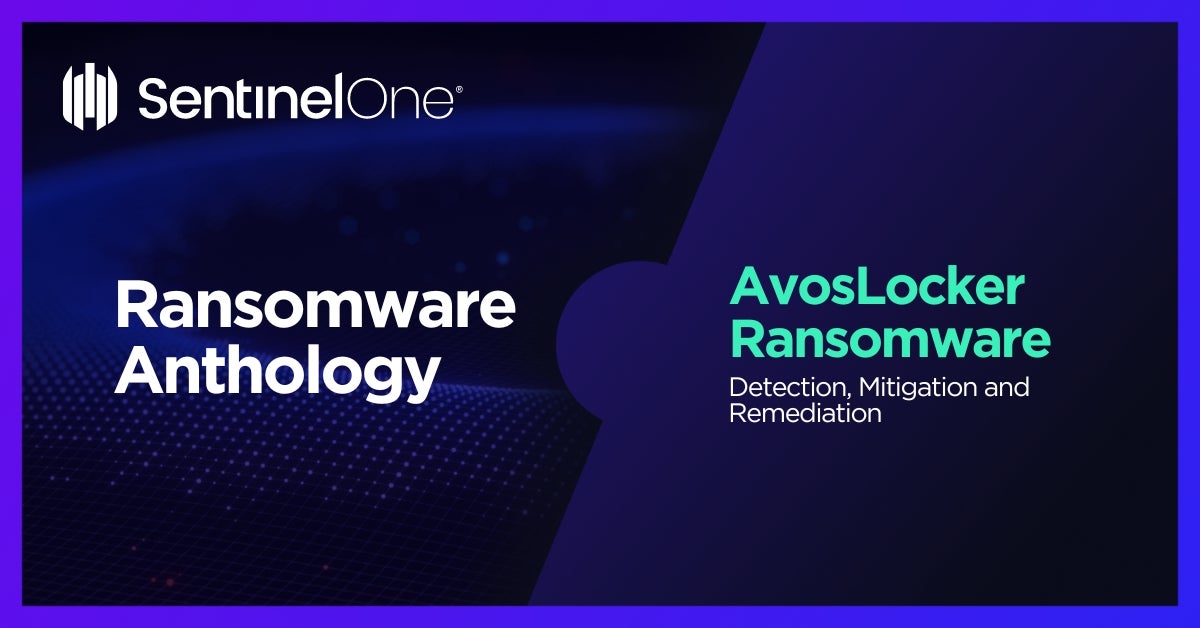AvosLocker Ransomware: In-Depth Analysis, Detection, and Mitigation
Summary of AvosLocker Ransomware
AvosLocker is one of the more recent ransomware families that came to fill the void left by REvil. It was first spotted in July 2021 and has since come up with several variants released over time. They also used this avenue to recruit additional team members and Initial Access Brokers (IABs). AvosLocker practices double extortion – demanding payment for a decryptor, as well as for the non-release of stolen data. AvosLocker launched with support for Windows payloads only, however a Linux variant was later released.AvosLocker operates as a ransomware-as-a-service (RaaS) model, targeting organizations based on their ability to pay the demanded ransom. While less prominent or active than LockBit or Conti, it is slowly making a name for itself, with the US Federal Bureau of Investigation (FBI) releasing an advisory on this threat.
AvosLocker has been targeting critical infrastructure in different sectors of the US, with attacks also observed in other countries like Canada, UK, and Spain. AvosLocker utilizes a remote administration tool (RAT) called AnyDesk to connect to victim machines. Its operators have set up certain drivers to ensure that AnyDesk runs even in safe mode. It also runs itself on safe mode as part of its evasion tactics, and operators have released multiple versions of this ransomware, including a Linux variant which is capable of attacking ESXi virtual machines. Furthermore, the group also auctions stolen data.

What Does AvosLocker Ransomware Target?
AvosLocker targets industrial, commercial, and SMB entities. Frequently targeted industries include automotive, trucking, healthcare, hospitality, education, and retail.
How Does AvosLocker Ransomware Spread?
AvosLocker is delivered in multiple ways: through Cobalt Strike or a similar framework, and through email phishing. Additionally, NetWalker has been observed exploiting known vulnerabilities in Microsoft Exchange including CVE-2021-34473, CVE-2021-31206, CVE-2021-34523, CVE-2021-31207.
AvosLocker Ransomware Technical Details
AvosLocker payloads require user interaction and display multiple, visible command windows. Some later samples have additional features, such as the ability to hide the CMD windows or exclude encryption of network resources. The ransomware also has routines that help it evade sandbox detection and move laterally. When it is executed with no options, it runs with the default and ignores encryption of SMB shares and network drives. It runs multiple concurrent threads for file encryption and displays progress status in the console window. After completion, the console window also displays the total number of locked objects and the time taken to encrypt.
With the RaaS service, AvosLocker launched a TOR-based blog site to publicize and track non-compliant victims and their looted data. Encryption is handled via a combination of RSA (encryption of directly-generated AES keys) and AES for actual encryption of files. Developers behind AvosLocker have touted the speed, claiming to be amongst the fastest available. File availability for encryption is determined solely by the file extensions.
How to Detect AvosLocker Ransomware
- The SentinelOne Singularity XDR Platform can identify and stop any malicious activities and items related to AvosLocker.
In case you do not have SentinelOne deployed, detecting this ransomware requires a combination of technical and operational measures, which are designed to identify and flag suspicious activity on the network. This allows the organization to take appropriate action, and to prevent or mitigate the impact of the ransomware attack.
- Use antimalware software, or other security tools, which are capable of detecting and blocking known ransomware variants. These tools may use signatures, heuristics, or machine learning algorithms, to identify and block suspicious files or activities.
- Monitor network traffic, and look for indicators of compromise, such as unusual network traffic patterns, or communication with known command-and-control servers.
- Conduct regular security audits and assessments, to identify vulnerabilities in the network and the system, and to ensure that all security controls are in place and functioning properly.
- Educate and train employees on cybersecurity best practices, including how to identify and report suspicious emails, or other threats.
- Implement a robust backup and recovery plan, to ensure that the organization has a copy of its data, and can restore it in case of an attack.
How to Mitigate AvosLocker Ransomware
- The SentinelOne Singularity XDR Platform can return systems to their original state using either the Repair or Rollback feature.
In case you do not have SentinelOne deployed, there are several steps that organizations can take to mitigate the risk of ransomware attacks:
- Educate employees: Employees should be educated on the risks of ransomware, and on how to identify and avoid phishing emails, malicious attachments, and other threats. They should be encouraged to report suspicious emails or attachments, and to avoid opening them, or clicking on links or buttons in them.
- Implement strong passwords: Organizations should implement strong, unique passwords for all user accounts, and should regularly update and rotate these passwords. Passwords should be at least 8 characters long, and should include a combination of uppercase and lowercase letters, numbers, and special characters.
- Enable multi-factor authentication: Organizations should enable multi-factor authentication (MFA) for all user accounts, to provide an additional layer of security. This can be done through the use of mobile apps, such as Google Authenticator or Microsoft Authenticator, or through the use of physical tokens or smart cards.
- Update and patch systems: Organizations should regularly update and patch their systems, to fix any known vulnerabilities, and to prevent attackers from exploiting them. This includes updating the operating system, applications, and firmware on all devices, as well as disabling any unnecessary or unused services or protocols.
Implement backup and disaster recovery: Organizations should implement regular backup and disaster recovery (BDR) processes, to ensure that they can recover from ransomware attacks, or other disasters. This includes creating regular backups of all data and systems, and storing these backups in a secure, offsite location. The backups should be tested regularly, to ensure that they are working, and that they can be restored quickly and easily.